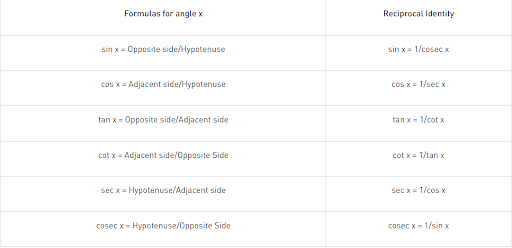Prove that \(tan\,4x=\frac{4\,tanx(1-tan^2x)}{1-6\,tan^2x+tan^4x}\).
Solution and Explanation
It is known that \(tan\,2A=\frac{2\,tanA}{1-tan^2A}.\)
∴L.H.S. = tan 4x = tan 2(2x).
\(=\frac{2\,tan2x}{1-tan^2(2x)}\)
\(=\frac{2(\frac{\,tan\,x}{1-tan^2x})}{-1(\frac{2\,tan\,x}{1-tan^2x})^2}\)
\(=\frac{(\frac{\,4tan^2\,x}{(1-tan^2x})}{[-1\frac{4\,tan^2\,x}{(1-tan^2x)^2}]}\)
\(=\frac{(\frac{\,4tan^2\,x}{(1-tan^2x})}{[\frac{(1\,tan^2\,x)^2-4\,tan^2\,x}{(1-tan^2x)^2}]}\)
\(=\frac{4\,tan\,x(1-tan^2x)}{(1-tan^2\,x)^2-4\,tan^2x}\)
\(=\frac{4\,tan\,x(1-tan^2x)}{1+tan^4x-2\,tan^2-4\,tan^2}\)
\(= \frac{4\,tan\,x(1-tan^2\,x)}{1-6\,tan^2x+tan^4x}=R.H.S.\)
Top Questions on Trigonometric Functions of Sum and Difference of Two Angles
- In the figure, the value of cosec A is

- TS POLYCET - 2021
- Mathematics
- Trigonometric Functions of Sum and Difference of Two Angles
- Prove that. \(2sin^2 \frac{π}{6}+cosec^2 \frac{7π}{6}–cos^2 \frac{π}{3}=\frac{3}{2}\)
- CBSE Class XI
- Mathematics
- Trigonometric Functions of Sum and Difference of Two Angles
- Prove that sin x+sin 3x+sin 5x+sin 7x=4 cos x cos 2x sin 4x.
- CBSE Class XI
- Mathematics
- Trigonometric Functions of Sum and Difference of Two Angles
- \(\text{tan x}=-\frac{4}{3},\text{x\, in\, quadrant \,II.}\)
- CBSE Class XI
- Mathematics
- Trigonometric Functions of Sum and Difference of Two Angles
- Prove that, cos 6 x = 32cos6 x-48cos4 x+18cos2 x -1.
- CBSE Class XI
- Mathematics
- Trigonometric Functions of Sum and Difference of Two Angles
Questions Asked in CBSE Class XI exam
Draw the Lewis structures for the following molecules and ions: \(H_2S\), \(SiCl_4\), \(BeF_2\), \(CO_3^{2-}\) , \(HCOOH\)
- CBSE Class XI
- Kossel-Lewis Approach to Chemical Bonding
- The following results are observed when sodium metal is irradiated with different wavelengths. Calculate (a) threshold wavelength and, (b) Planck’s constant
λ (nm) 500 450 400 v × 10–5(cm s–1) 2.55 4.35 5.35 - CBSE Class XI
- Atomic Models
- Briefly comment on "The purpose of the author’s journey to Mount Kailash."
- CBSE Class XI
- Silk road
- Mention the three phases of the author’s relationship with his grandmother before he left the country to study abroad.
- CBSE Class XI
- The Portrait of a lady
- What do you understand by isoelectronic species? Name a species that will be isoelectronic with each of the following atoms or ions.
- F-
- Ar
- Mg2+
- Rb+
- CBSE Class XI
- Electronic Configurations Of Elements And The Periodic Table
Concepts Used:
Trigonometric Functions
The relationship between the sides and angles of a right-angle triangle is described by trigonometry functions, sometimes known as circular functions. These trigonometric functions derive the relationship between the angles and sides of a triangle. In trigonometry, there are three primary functions of sine (sin), cosine (cos), tangent (tan). The other three main functions can be derived from the primary functions as cotangent (cot), secant (sec), and cosecant (cosec).
Six Basic Trigonometric Functions:
- Sine Function: The ratio between the length of the opposite side of the triangle to the length of the hypotenuse of the triangle.
sin x = a/h
- Cosine Function: The ratio between the length of the adjacent side of the triangle to the length of the hypotenuse of the triangle.
cos x = b/h
- Tangent Function: The ratio between the length of the opposite side of the triangle to the adjacent side length.
tan x = a/b
Tan x can also be represented as sin x/cos x
- Secant Function: The reciprocal of the cosine function.
sec x = 1/cosx = h/b
- Cosecant Function: The reciprocal of the sine function.
cosec x = 1/sinx = h/a
- Cotangent Function: The reciprocal of the tangent function.
cot x = 1/tan x = b/a
Formulas of Trigonometric Functions:
